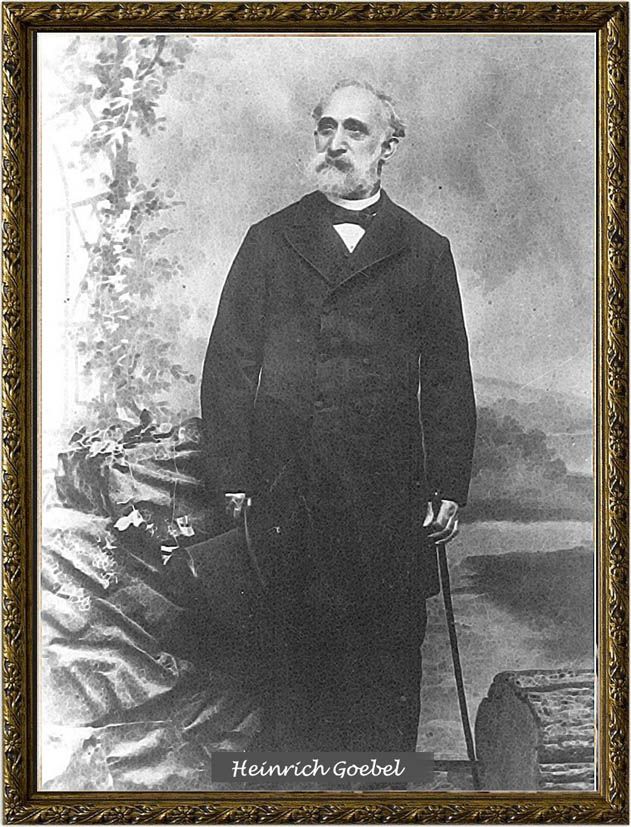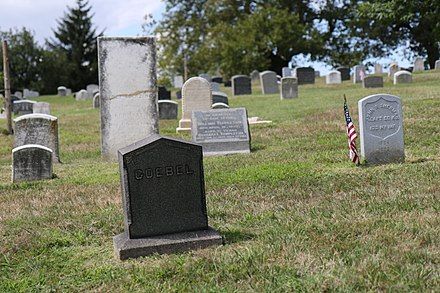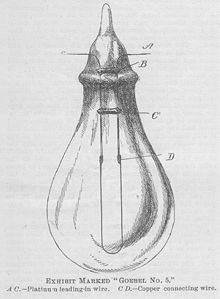NOTE: His name is also seen as Heinrich Gobel.
He was born in Springe, about 15 miles S.W. of Hannover.
He died at home, 504 Sixth Avenue. (Page 14 - "The Jewelers' Circular and Horological Review", New York - December 13, 1893 - Volume XXVII, Number 20)
He and his wife arrived in New York City on the ship "J.W. Andrews" in 1849. The above source says on February 2.
He was a watch & clock maker, and also an optician.
Famous inventor. He lost a court case with Edison over the invention of the incandescent light bulb. Goebel claimed to have invented it in 1854, but never applied for a patent.
He did have 3 U.S. Patents:
- 47,632 on on May 9, 1865 for an "Improvement in Hemmers for Sewing-Machines"
- 252,658 on January 24, 1882 for a "Vacuum-Pump"
- 266,358 on October 24, 1882 for an "Electric Incandescent Lamp"∼Inventor and precision mechanic.
Electric light first inventor. In 1854, Goebel's experiment became a reality and the electric lamp shone on humanity for the very first time in history.
Heinrich Göbel or Henry Goebel (April 20, 1818 - December 4, 1893), born in Springe, Germany, was a precision mechanic and inventor. In 1848 he emigrated to New York City, where he lived until his death.
Married to; Sophie Betty Julie Lübke, born Rodewig i Springe, Deutschland 1827. Sophie dies 1887 in USA.
Children:
Ernst August 1844, Johann Carl 1846, Marie Sophie 1848, Henry 1855, Adolph Otto 1856, Lizzie 1858, Celestina 1861
Annie 1865, William 1867, George 1871
He gained American citizenship in 1865. In 1893, newspapers reported that in 1854 and 25 years earlier, Goebel had developed incandescent lamps comparable to those invented in 1879 by Thomas Alva Edison. Goebel did not apply for a patent. There was a lot of excitement and attention when Heinrich Goebel, a few years after his arrival in New York, attached an arc-shaped lamp to the roof of his house, which was powered by a battery made of zinc and carbon elements. Goebel's neighbors informed the police and he was arrested. The judges never sentenced Goebel and ruled that he would not be bothered by this in the future. In 1854, his experiment became a reality and the electric lamp gave light to humanity for the first time in history.
Goebel defence: During what was called "Goebel's defense", over a hundred witnesses were called in to Goebel's defense. While in the first and second instances the objections to the Edison patent were rejected, because it was not considered that the Göbel lamp corresponded to the practical requirements that could be placed on a light bulb, the third instance, after a further large number of experts were heard, came to it the result that "through many facts and studies it would be proven that the Goebel lamp had been a truly usable light source, that is, Goebel had already been in use for 25 to 30 years before Edison and the public was shown a practically usable light bulb".
Shortly after the decision of the process, Göbel died on December 4, 1893. The Göbel lamp was, as he himself stated at one point during the process, well done, but the time was not yet ready to put into use his invention.
He deserves to take a place among the pioneers of electrical engineering.
https://www.wikiwand.com/en/Heinrich_G%C3%B6bel#/Litigation_using_the_%22G%C3%B6bel_defense%22_in_1893_and_1894.
NOTE: His name is also seen as Heinrich Gobel.
He was born in Springe, about 15 miles S.W. of Hannover.
He died at home, 504 Sixth Avenue. (Page 14 - "The Jewelers' Circular and Horological Review", New York - December 13, 1893 - Volume XXVII, Number 20)
He and his wife arrived in New York City on the ship "J.W. Andrews" in 1849. The above source says on February 2.
He was a watch & clock maker, and also an optician.
Famous inventor. He lost a court case with Edison over the invention of the incandescent light bulb. Goebel claimed to have invented it in 1854, but never applied for a patent.
He did have 3 U.S. Patents:
- 47,632 on on May 9, 1865 for an "Improvement in Hemmers for Sewing-Machines"
- 252,658 on January 24, 1882 for a "Vacuum-Pump"
- 266,358 on October 24, 1882 for an "Electric Incandescent Lamp"∼Inventor and precision mechanic.
Electric light first inventor. In 1854, Goebel's experiment became a reality and the electric lamp shone on humanity for the very first time in history.
Heinrich Göbel or Henry Goebel (April 20, 1818 - December 4, 1893), born in Springe, Germany, was a precision mechanic and inventor. In 1848 he emigrated to New York City, where he lived until his death.
Married to; Sophie Betty Julie Lübke, born Rodewig i Springe, Deutschland 1827. Sophie dies 1887 in USA.
Children:
Ernst August 1844, Johann Carl 1846, Marie Sophie 1848, Henry 1855, Adolph Otto 1856, Lizzie 1858, Celestina 1861
Annie 1865, William 1867, George 1871
He gained American citizenship in 1865. In 1893, newspapers reported that in 1854 and 25 years earlier, Goebel had developed incandescent lamps comparable to those invented in 1879 by Thomas Alva Edison. Goebel did not apply for a patent. There was a lot of excitement and attention when Heinrich Goebel, a few years after his arrival in New York, attached an arc-shaped lamp to the roof of his house, which was powered by a battery made of zinc and carbon elements. Goebel's neighbors informed the police and he was arrested. The judges never sentenced Goebel and ruled that he would not be bothered by this in the future. In 1854, his experiment became a reality and the electric lamp gave light to humanity for the first time in history.
Goebel defence: During what was called "Goebel's defense", over a hundred witnesses were called in to Goebel's defense. While in the first and second instances the objections to the Edison patent were rejected, because it was not considered that the Göbel lamp corresponded to the practical requirements that could be placed on a light bulb, the third instance, after a further large number of experts were heard, came to it the result that "through many facts and studies it would be proven that the Goebel lamp had been a truly usable light source, that is, Goebel had already been in use for 25 to 30 years before Edison and the public was shown a practically usable light bulb".
Shortly after the decision of the process, Göbel died on December 4, 1893. The Göbel lamp was, as he himself stated at one point during the process, well done, but the time was not yet ready to put into use his invention.
He deserves to take a place among the pioneers of electrical engineering.
https://www.wikiwand.com/en/Heinrich_G%C3%B6bel#/Litigation_using_the_%22G%C3%B6bel_defense%22_in_1893_and_1894.
Inscription
GOEBEL
Family Members
Advertisement
Advertisement










